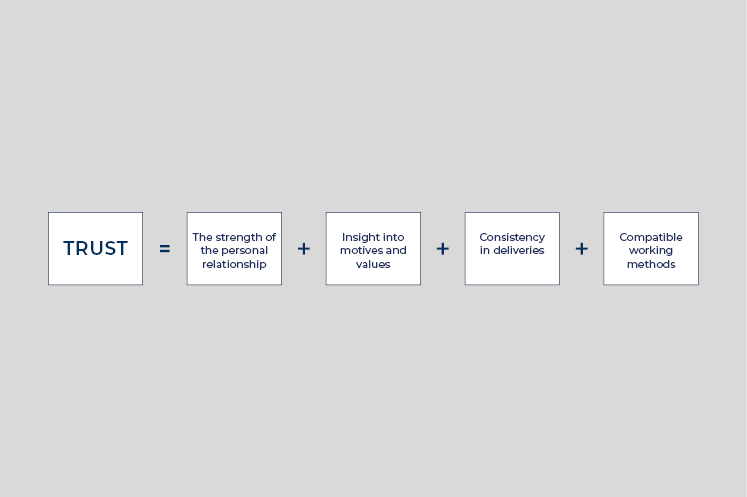For managers: Develop a better environment for hybrid work
Build trust at a distance

This article was written by Lars Pedersen, owner and senior consultant at Pitstop Management and author of the books Er der en leder til stede? (Is there a manager present?) (2017) and Samarbejde - hver for sig (Collaboration - when working apart) (2020)
Do you recognise the following situation? It is Monday morning and there is a high-spirited atmosphere at the office following a weekend where everyone has been recharged with new energy. You are gathered in the kitchen, and Louise has brought fresh, homebaked rolls.
Niklas is strutting like his 14-month-old daughter, who took her first steps yesterday. Karoline is telling jokes from the stand-up show she saw on Saturday evening. People get on well, great team you are managing – the week can only turn out well.
You look at the plan for the week. The team discuss a few of the meetings for the day, and Fatima and Niklas agree that they want to go over their plans for a workshop on Wednesday.
Francis invites two colleagues to brainstorm a good idea he got on his bike at the weekend. "Does anyone want the last roll"? Louise asks as she clears the table.
Distance makes relationships weaker
This seems like a flying start to the week for a team that get on well, although there is a BUT.
Because your team is a team of 12. In addition to the eight people who came to the office this morning, Caroline has been lent to another office all week, and Anne, Svein and Peter are working from home until Wednesday. What about them? Will they start their week full of energy? Would one of them have wanted the last roll?
Presence is crucial for our perception of one another. A team of researchers have worked on this using two key concepts:
- Active face time: when we communicate in direct conversations and meetings.
- Passive face time: when we are together with other people and acknowledge one another.
The informal must be formalised
When we work together at a distance, we have plenty of active face time through online meetings and one-to-one conversations. However, we lose the passive face time. When we work in the same room or meet each other on the stairs or in the canteen, we send and receive a lot of signals to each other, both intentionally and unintentionally.
Eye contact, a smile, a small nod, a 'new shirt - wauw', 'good seeing you', 'good morning' and 'have a nice weekend'. It is about being seen, met and recognised, and the effect of passive face time is essentiel for cohesion in a collaboration.
The informal must therefore be formalised when working together at a distance. You have to create a structure and a working culture in which informal chats, coffee breaks, lunches and similar are entered in the calendar. Do not think about relationship building as a social and less important thing that you pay attention to when you have time. Relationships and mutual trust will grow when you are together and talk. Trust is a prerequisite for knowledge-sharing and synergy, and it is the way to achieving the objectives of collaboration.
Relationships promote knowledge-sharing
So, relational work is not just important for each of you individually. It also creates value for the organisation. Knowledge-sharing is gold in cross-cutting collaboration, but when you are spread across many workplaces, you can end up in mental silos. You work like pearls on a string, but the string (the community) is missing.
Distance management and hybrid management are about being present and building close relationships and a common understanding of the core task. At a distance, you work together and communicate virtually, and this places demands on your IT platforms and equipment. But ultimately you the team have to make the technology create value. You must therefore invest time and energy in creating the virtual/hybrid team.
What should you communicate and where?
Be aware of your priorities when you are together. How do you create value for the collaboration when the bandwidth is the greatest (face-to-face)? And what works well at a distance?
The communicative bandwidth is narrower when you are at a distance. We have all received an email which is easy to read, but difficult to understand. What lies between the lines? Why are there two exclamation marks at the end? When you know each other well and have a high level of trust, you minimise the risk of misinterpretation, frustration and doubt, and then most things are possible at a distance.
Distance management – it is all about trust
The trust formula here is a specific suggestion on how you can work with trust in relationships across workplaces.

1. Build personal relationships
As a manager and as staff, you each have your role at work. At the same time, you are people with families, interests, backgrounds, qualifications, leisure time and different life situations. Being personal, open and transparent is important, but you do not have to share private information. There is a limit, and each individual must draw their own limit. But remember that trust is not something you can demand. Trust is something you have to earn by behaving with credibility.
2. Gain insight into motives and values
The more we know about each other's intentions and motives, the better we can interpret their communication, and this can be particularly challenging when communicating in writing or on a screen. So, ask what your colleague wants to achieve, what she prioritises and what she needs from you. It is also important that you talk about your personal values in the collaboration. Your values are the answers to what is important for you to function optimally in the virtual working environment. Talk about what needs to be in place to ensure that you can each exploit your potentials and create value in the collaboration. When you talk about what is important to you, you talk about your personal values.
3. Be consistent and keep agreements
Building trust is also about agreements, and that what you deliver is delivered at the agreed time and at the right quality. When you lack the skills you need to do a task or you cannot keep deadlines, it is crucial to communicate openly and honestly. Otherwise, the trust will start to crack.
4. Agree on working methods
Agree on your channels of communication. The entire team should use and be active on the media you have decided to use as your platform. Furthermore, respect processes and work tools. Every time someone does something different from their workplace, new processes start to crop up, and suddenly a situation can develop into individual considerations rather than consideration for the community.
Download the trust formula as tools here.